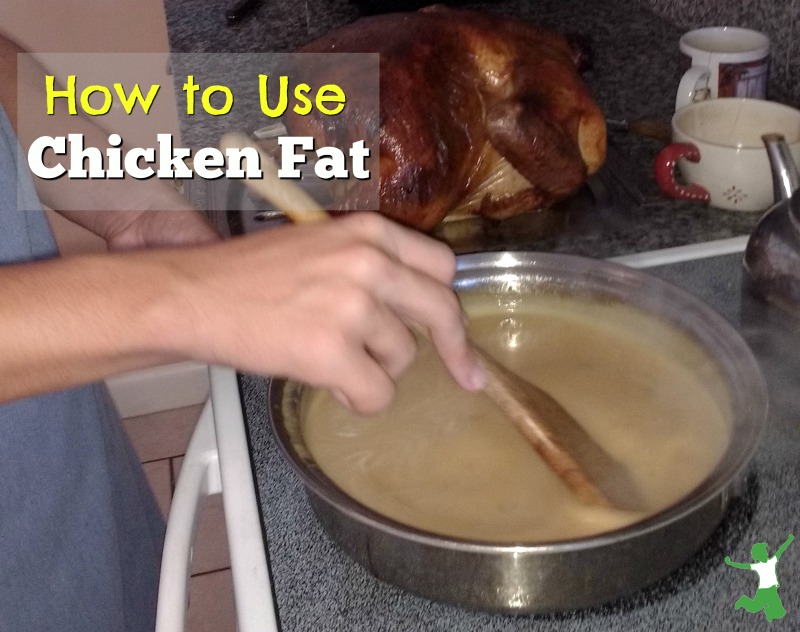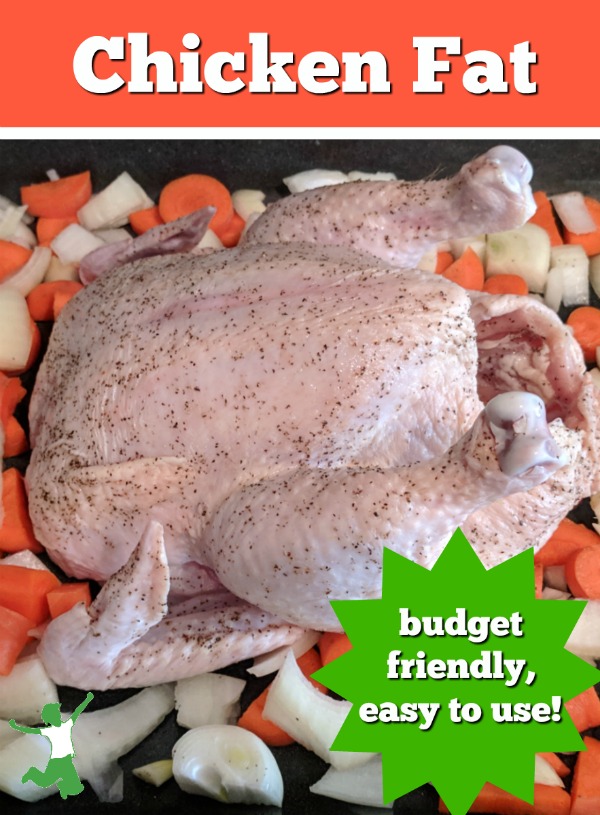Chicken fat or schmaltz is a traditional fat, very budget-friendly and quite healthy to use. Be sure to follow these important cautions if you choose to cook with it on a regular basis.
A recurring theme on this site is the critical importance of utilizing Traditional Fats for cooking. Avoiding industrialized factory fats that are rancid from processing and devoid of nutrients is critical to long term health. These frankenfats include margarine, spreads and vegetable oils. Is chicken fat, also called schmaltz, one of these fats?
Let’s take a look in-depth.
Is Chicken Fat Healthy?
The type of fats you choose for cooking can literally make or break your health!
This is the case regardless of other kitchen practices that may be right on target such as sourcing local and organic produce, consumption of antibiotic/steroid-free grass-fed meat, and use of freshly ground flour to prepare traditionally made baked goods.
Factory fats such as hydrogenated/partially hydrogenated oils (trans fats) are obviously unhealthy. Less obviously damaging are the heavily marketed liquid edible oils. These include soy, rice bran, corn, grapeseed, safflower, sunflower, canola, pumpkin seed oil, and others as they are modern fats only recently introduced to the human diet.
Consumption of these industrialized fats can cause cancer, heart disease, immune system dysfunction, fertility problems, learning disabilities, growth problems, and osteoporosis. They are inflammation in a bottle! They must be vigilantly avoided to achieve maximum health and vitality. (1)
Nutrient-rich traditional fats best used for cooking include the following:
- Butter
- Ghee
- Lard from pigs outside in the sunlight (this recipe plus video shows you how to render lard at home)
- Tallow and suet from beef and lamb
- Chicken and goose fat (schmaltz), and duck fat
- Coconut, palm kernel, red palm oil, and palm oil
These traditional fats are primarily composed of saturated and monounsaturated fats. They maintain their integrity when heated, meaning they do not become denatured forming free radicals during the cooking process. This is true as long as the heat remains below the smoke point. These fats have nourished healthy cultures for millennia.
Wondering why olive oil is not on this list? This article outlines the reasons I choose not to cook with olive oil although it is great for salad dressing and is definitely a healthy traditional fat.
Chicken Fat vs Other Nourishing Fats
What many folks do not realize is that all fats are actually a combination of saturated, monounsaturated, and polyunsaturated fats.
Polyunsaturated vegetable oils are the rancid ones full of free radicals that are used in processed foods. They are the bad fats that when consumed to excess as is the case in the Western diet, inflammation and degenerative disease is the result. Vegetable oils also contribute to a tendency to gain weight.
A common characteristic of nearly all traditional fats is that they are all very low in polyunsaturated fats. The one exception is chicken fat which is about 21% polyunsaturated (2).
This compares with a polyunsaturated fat content of the following nourishing fats. (2)
- 4% for butter and ghee
- 4% for beef tallow
- 8% for mutton tallow
- 11% for goose fat
- 12% for duck fat
- 3% for coconut oil
- 9% for palm oil
- 2.3% for palm kernel oil
Cautions using Schmaltz
If you are new to Traditional Diet and your pantry is still fairly loaded up with processed foods in the form of chips, crackers, cookies, etc – even if organic – it is best to use another traditional fat for cooking than chicken fat.
This is because eating even a moderate amount of processed foods will likely result in an excessive intake of polyunsaturates. Cooking with chicken fat will exacerbate the problem as it is the highest in polyunsaturates of all the traditional fats with the exception of sesame oil. A much better choice would be to cook with one or more of the traditional fats listed above that are very low in polyunsaturates.
On the other hand, if you have eliminated most processed foods from your diet and are eating nearly all whole, home-prepared snacks and meals at home, then cooking with schmaltz poses no problem whatsoever.
The reason? There isn’t an excessive amount of polyunsaturated fats in your diet already.
Healthful and Budget Friendly
I hope this article has not put anyone off chicken fat! That was certainly not the intention.
This wonderful traditional fat is fabulous to include in the diet. However, the caveat is the high polyunsaturated content that is not common knowledge for many people.
Instead, I hope this information motivates you to further reduce your family’s use of any remaining processed foods.
Then, you can fully enjoy and utilize the budget-friendly convenience of chicken fat with complete peace of mind.
It is so simple to gather rendered schmaltz into a jar. Simply peel it off the top of a quart of chilled homemade chicken stock! Then, use it for vegetable sautes, stir fry and other savory dishes. It keeps for weeks when refrigerated.

How to Use for Maximum Health Benefits
Think you’re ready to use chicken fat? A good rule of thumb to know for sure is to open your pantry and take a look. If you see a lot of boxes from the store, you should be doing your cooking with a traditional fat.
These fats include butter, ghee, coconut oil, tallow, lard, and suet. Palm, goose and duck fat, while a bit higher in polyunsaturates, would also be fine for cooking occasionally even if some processed foods still remain in your family’s diet.
Save the chicken fat for when you are more fully transitioned to Traditional Diet. This approach ensures that no overconsumption of polyunsaturates occurs which would keep the brakes on your journey to optimal health.
Once you get to that point, there is quite possibly no cooking fat that is easier on the budget than schmaltz!
References
(1) Principles of Healthy Diets
(2) Chicken Fat Nutrition Data
(3) Schmaltz
More Information
Selecting a Healthy Cooking Fat and Reusing it Safely
Argan Oil Benefits Health
Walnut Oil: Healthy Sub for Flax Oil








This was such an informative article. I often cook chicken confit with duck fat or chicken fat. I was not aware chicken fat contained so much polyunsaturates. However, do you know if slow cooking meat in fat, which is the confit process, is more unhealthy than deep frying? Or does it depend on the fat you’re using?
I think the ratio of O-3s & O-6s is what was meant as the problem, though that is not brought out in the article. Obviously, the chicken fat, when rendered by the home cook & when it’s from a good source, isn’t highly processed like store bought PUFAs. Be sure and refrigerate this fat.
I just found your articles and do appreciate the discussions. Could you tell me if and why it would be okay to use rendered turkey instead of chicken fat. Blessings and thanks.
How about cold pressed vegetable oils? They are less evil than hydrogenated ones and has high smoke point too, right?
I don’t use them because they are high in omega 6 fats which the Western diet is already too high in … excess of these fats is a problem (they are essential yes, but too many in the diet is inflammation producing).
Permanent installations in vehicles gave way to the portable Bag Phones,
furnished with a cigarette lighter plug. According to Alexandra Juhasz, professor of media studies at California’s Pitzer College and one with the
course facilitators, approximately 300 students have enrolled in
the course, which falls underneath the Fem – Tech – Net
rubric ‘Dialogues on Feminism and Technology. * Create and
distribute Widgets or Mash-ups using services like widgetbox, Open Social,
or Yahoo Pipes.
Hi Sarah,
When making traditional chicken broth, can you please clarify on when and why to skim or not skim? Thanks!
Hmm… now I’m confused! I don’t skim the fat from my broth. I just leave it in there and eat it in the broth (soups, etc), because I thought the animal fats are good for us, help the adrenals, etc. And now that I’m giving my baby chicken stock, I’m wondering if it’s okay that I leave the fat in the broth I give him as well. I certainly don’t want to start him off with a tendency toward ill health and inflammation – which is why I’m giving him broth instead of rice cereal in the first place! Am I doing something wrong by leaving the fat in the stock?
I get your point…but it almost seems silly to worry about chicken fat, even if you have SAD food in the pantry. When I cook the free range chickens I buy and then make stock from, even if I throw the skin in, I only get a couple of tablespoons of fat for future cooking (or to incorporate into soups). I can hardly cook two sides of veggies with that. Is it normal to have much more?
Should I look for a new source for my chickens?